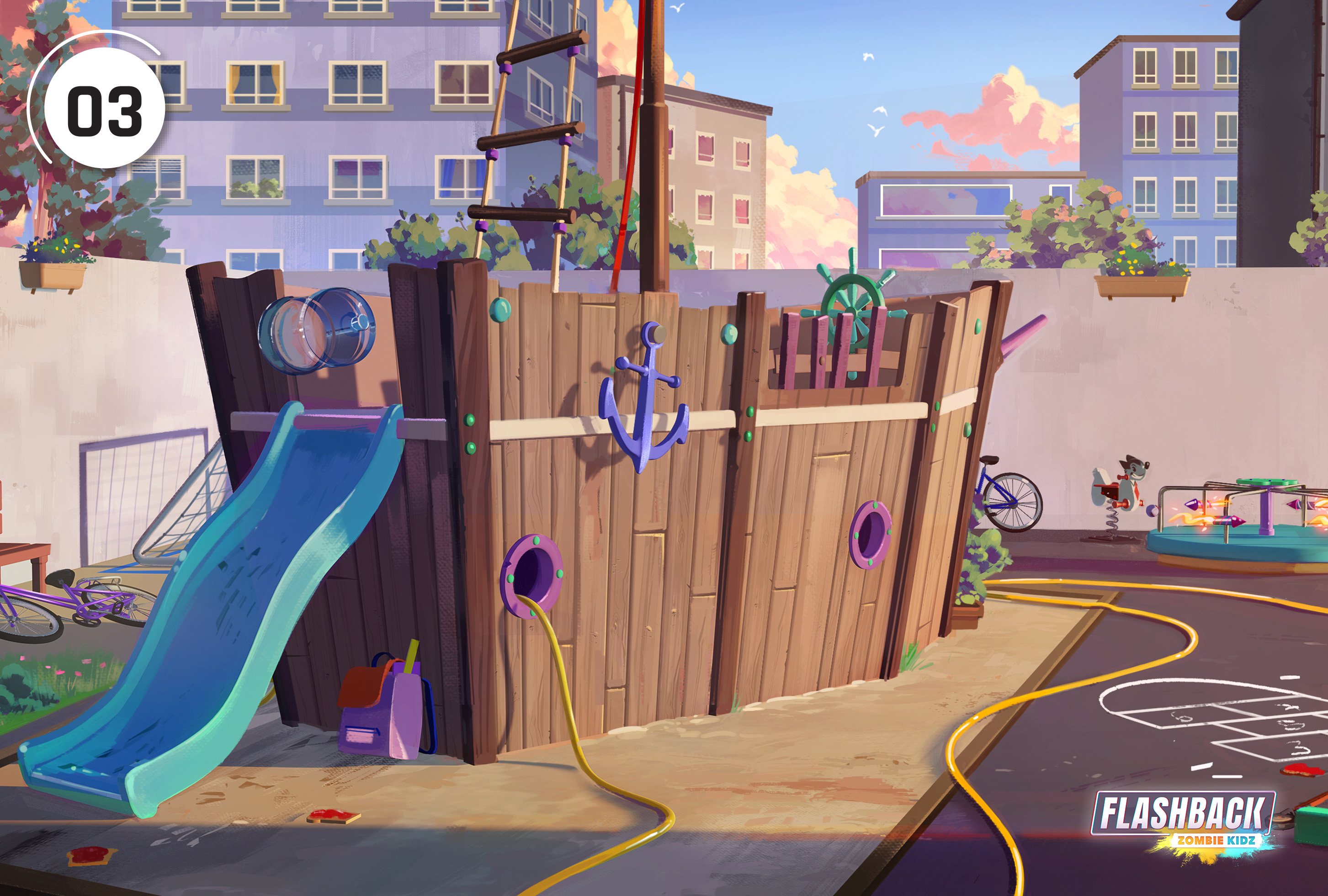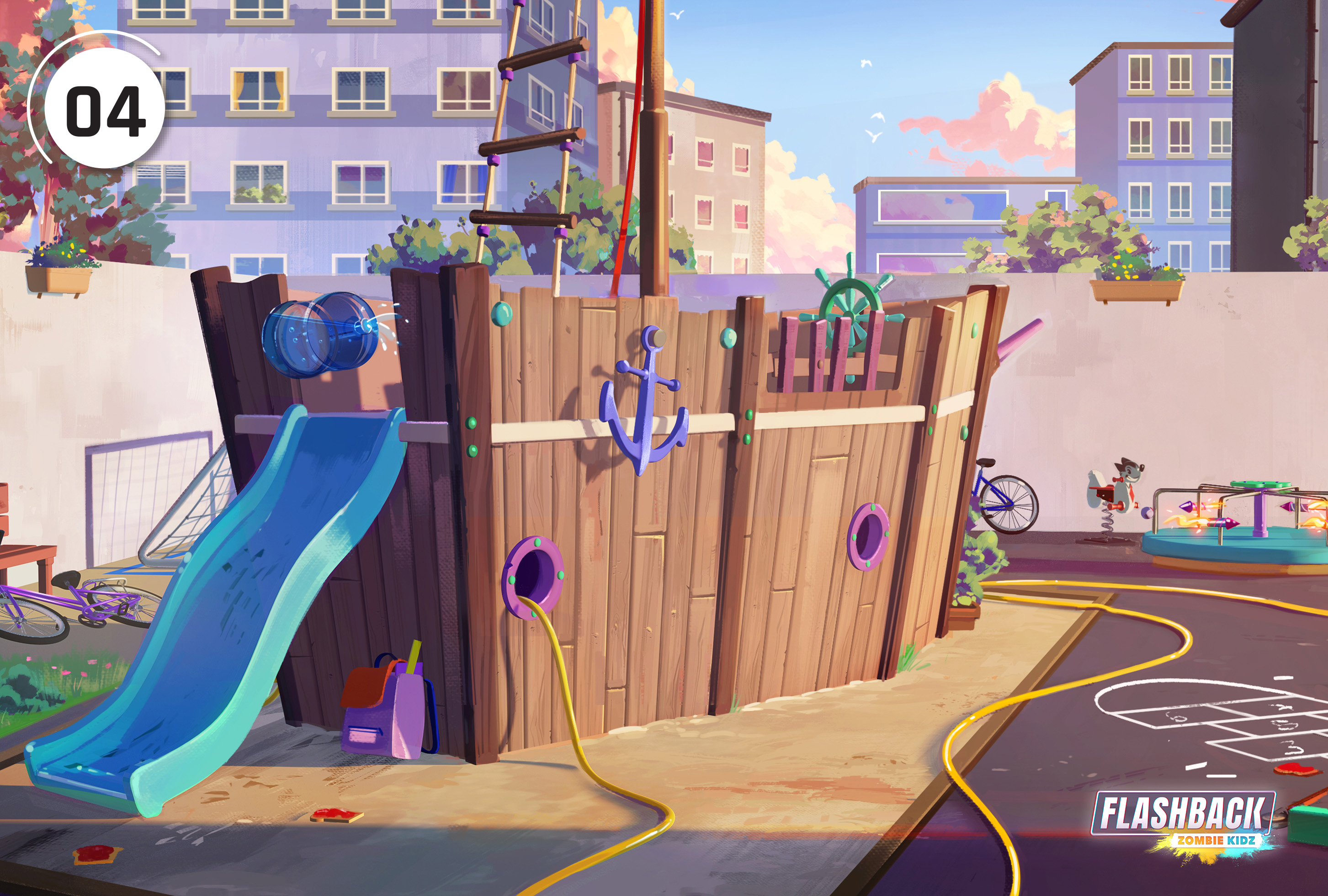Flashback ...
[Flashback : Zombie Kidz Evolution is the first game in the Flashback series, designed by Baptiste Derrez and Marc-Antoine Doyon, and published by Scorpion Masqué, in the Zombie Kidz universe created by Annick Lobet]

credit : Michel Verdu
At the beginning
Baptiste : In 2021, I sent an e-mail to Christian Lemay of Scorpion Masqué asking if he'd be willing to take a look at one of my ideas. This was my first real board game prototype, and the first time I'd approached a publisher. He quickly replied that he was very interested in the project, and then asked me if I'd be willing to work with someone. I replied that I'd love to work with someone. It's easier for me to work with others.
Marc Antoine : It was in the summer of 2021 that Christian contacted me with the idea of working on “something cool”. As he's a friend I generally trust, I immediately accepted before he even explained anything to me.
“Design...writing...Baptiste...magic...zombies...” I'd barely heard a few words before I was completely charmed and excited at the idea of working on A GAME. What I didn't know was that I was jumping into the most complex, strange and rewarding project I'd ever done.
Baptiste : Some time later, I met up with Marc-Antoine and the rest of the team by videoconference (due to the fact that I'm in France, and the rest of the team is in Quebec) to talk in more detail about the project and to determine how everyone saw the game’s development process. Everyone was very motivated by the ideas and were very willing to listen.
I presented my basic idea: A scene frozen in time, in which we're able to move through the characters' different points of view to see the scene from different angles and to understand what happened.
Marc-Antoine : First meeting with the team: I loved Baptiste's concept. There was something extremely elegant and streamlined about it, but that also drew on the intellect of the players at the same time. With very little initial information, a world unfolded before us, and we found ourselves hypothesizing about all the possible whys and wherefores. And what's more, the Scorpion team wanted to develop the first box under the banner of Zombie Kidz, the best kids’ game out there! That was all it took to convince me... even if I was already convinced.
Before writing the script, Baptiste and I decided to draw up a list of unique points of view and scenes we would like to see in the game. Being the eternal student that I am, I read Thom's dissertation on narration through images, which inspired me enormously and confirmed that my film background would not be entirely useless...
La V.1 du jeu
Baptiste : I had my scenario in my head, some ideas of how to arrive at different solutions, and the unique points of view. The difficulty was to produce a version that could be tested and understood, as my initial stick figures weren't enough to give a good understanding of the situations.
Marc-Antoine : Right from the start of the project, we had lengthy discussions with Baptiste to find out what the right workflow would be , which program we would need to use, on which platforms, how often... we had to figure it all out. We soon realized that the memories had to be created completely in 3D to avoid perspective errors.
In addition to this, seeing as how we wanted the illustrators to create the Kidz universe using the same method, we figured we might as well save them (a little) work and ensure a smooth transition between the prototype and the illustrated version. After a few unsuccessful tests, I rolled up my sleeves and sat down to learn how to use Cinema 4D, a great tool that lets you model scenes in 3D and walk through them with a camera as if you were there. The magic was already taking shape.
The first version, seen in Cinema 4D
While I was doing this, Baptiste and I began seriously brainstorming and writing the first version of the first scenario (not yet called Memory). Several ideas were adopted and others discarded or reworked. There were elements we really wanted: A first card full of different points of view, a blurry point of view, perspective effects, a flying zombie...
Baptiste : I already had the idea of the school, of the zombies who had managed to get into the playground, of what was underneath, but not exactly of all the nooks and crannies and surprises to discover. For the first scenario, I worked together with Marc Antoine to put together a concept as complete as possible. We bounced ideas off each other. The writing process was fluid and very interesting.
Marc-Antoine : You can see, in this first version, that the more offbeat ideas like the distorted television, the kaleidoscope, or the zombie baby were abandoned in the end.
Glory to the Zombie Baby!!
Playtests
Now came the most important and challenging part of the game’s development: Playtesting. Luckily, there are plenty of mums and dads in the Scorpion Masqué office who were happy to offer their families’ services to see how our game played in real life. We quickly realized the value of our playtesters, because a narrative investigation game can't be tested twenty times by the same person.
Baptiste : For my part, it was a bit harder to find testers. Between my limited circle of acquaintances and those who wanted to play the final version, I didn’t have many testers at my disposition. Fortunately, a lot of the feedback generated proved to be useful for future iterations. Marc-Antoine and I held weekly debriefing sessions, and the scenario was fine-tuned.
Marc-Antoine : The playtests underlined a lot of things that were bothering us but that we weren’t really able to put our finger on. But they also confirmed the most fundamental thing: the game was fun! People genuinely enjoyed discovering the cards, and that's all that really matters.
Another thing I love about testing is that it becomes the ultimate lever when you're not sure about a puzzle or an image: let's test it to see if it works, and then adjust! The catch is that when you change something in an investigative game, the thing you changed has to move EVERYWHERE (especially when all points of view are linked). The whole team has to be ultra-alert from the very beginning to the very end of production, to ensure that the fewest errors possible are overlooked.
The other snag is that my drawing skills are pretty limited, so we were often faced with the question: “What's that squiggle supposed to be?” So often, in fact, that it became one of my favourite arguments to justify a slightly twisted mystery: “Oh, but you'll see, when it's drawn up properly, you’ll understand everything!” Sometimes it was true, sometimes it wasn’t...
Versions 2-3-4-500 of card 01
Basic Rules
Baptiste : There were several useless cards (an all-black card which was the point of view of a sleeping cat, for instance) in my prototype and in my basic idea, but we soon realized that “red herring” or deceptive cards wouldn’t fit into the final quantity of cards.
Marc-Antoine : Over the course of the different versions and playtests, several rules emerged. Some stemmed from a desire to tell a logical, rich story, while others emerged as the best option for a dynamic, fluid experience.
The list is long, but here are just a few:
- All cards must have a purpose (information or surprise).
- Some cards should lead to several points of view at regular intervals.
- It's important to understand the concrete link from one point of view to another.
- Every visible character has a point of view, or a reason for not having one.
- If the element is essential to understand the overall scenario, it must be linked to a question.
- Even absurd elements must have a minimum of logic.
Basically, you can now probably understand that all of these considerations can quickly become a monumental headache... But they say that from constraint comes creativity.
More sketches for your viewing pleasure.
Illustrations and Production
Once Memory 1 was finished and confirmed, we were joined by Jenny and Laure, who illustrated the backgrounds and accessories. I said it many times throughout the process, but their talent, patience and immediate understanding of our world and the game are at the heart of the project's success. They breathed an incredible amount of life into every image we had in mind, and I'm so grateful to them for that. They even managed to make sense of some of our most incomprehensible puzzles, as I had predicted (or not).




from the first 3D rendering of Card 01 to the final illustration by Laure de Chateaubourg
Then Michel Verdu joined the team. He overcame the incredible challenge of making the Kidz and the Zombies his own, always adding a fun, offbeat twist. The expressions and stances of the characters are super important, because it's through them that we are able to understand most of what's going on in Flashback. And I think it was a great success.
Over the following months, we held weekly meetings to discuss in great detail a universe that no longer looked so much like a game, but rather a colorful labyrinth hiding challenges and surprises around every corner. I remember absurd questions like, “If we place the bowling ball this way, can it look like a head?”, “Can the flying zombie be wearing sunglasses?”, “Why is the cheese in a can if it's already rotten?”. Fortunately, our wacky ideas were supported by a team of incredible graphic designers who boosted their efforts to bring this crazy ship to harbour. They brought impressive expertise and inventive solutions that clearly became the heart of the magic.
So thanks to Manu, Christian, Sébastien, Karine, Émilie, and Hélène.
Conclusion
Creating a game is a strange undertaking, one in which hilarious questions can end up being taken very seriously, all in the aim of giving strangers a few hours of fun. For me, it represented a monumental team effort, a lot of learning and fun, but above all the realization that this is what I want to do for the next few years of my life: Make games with people who make magic.
Baptiste : This is my first published game, and I don't know if you can dream of anything better for your first game. A rewarding year's work, a great team always in a good mood, lovely people who listen and are talented, a game that was well received by the public, and an As d'Or at the Festival International de Jeux de Cannes. Since that experience, I've come to realize that game creation isn't just for other people, and that I too can come up with the crazy stuff that's in my head.

credit : Jenny Mati
And if you want to see even more of the creative process for Flashback : Zombie Kidz Evolution, here are Art Stations of the illustrators :
Michel Verdu : https://michelverdu.artstation.com/projects/aGWO8J
Jenny Mati : https://www.artstation.com/artwork/b5LwPo
Laure de Chateaubourg : https://laure_de_chateaubourg.artstation.com/projects/RnRBYr

Take a peek behind the curtain...
Once a month Scorpion Masqué's Grand Poobah shares his thoughts with you. From how the market has evolved, to writing rules that make sense, with detours into game mechanisms, you will get a glimpse at the board game industry from the point of view of a publisher.
Copyright © 2025 - Le Scorpion Masqué



